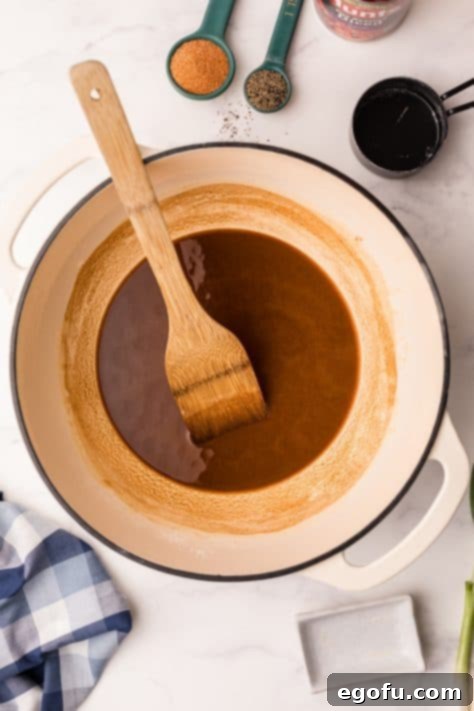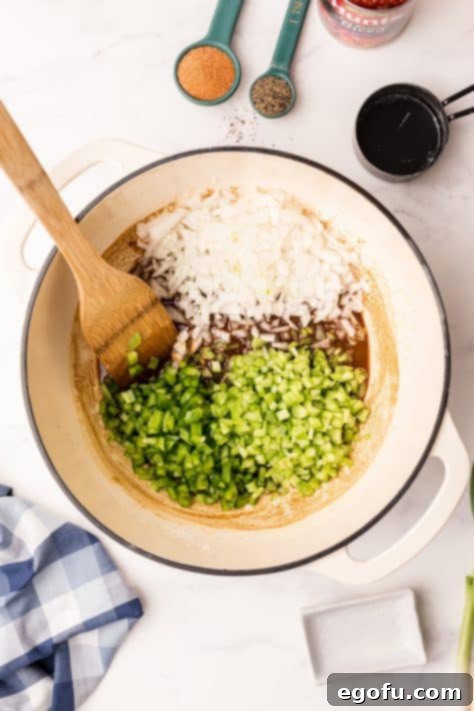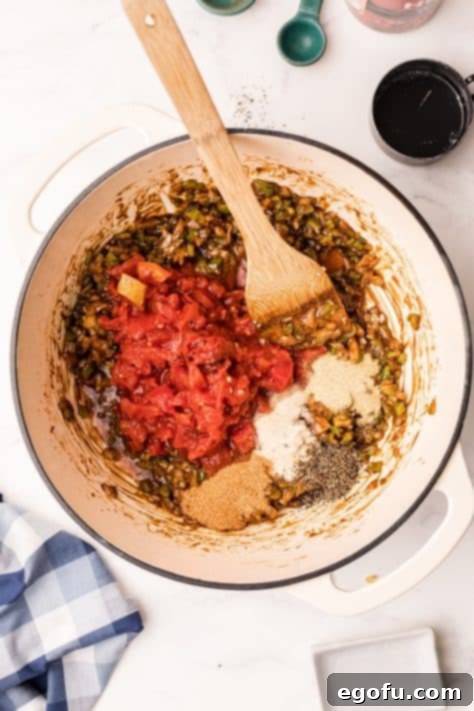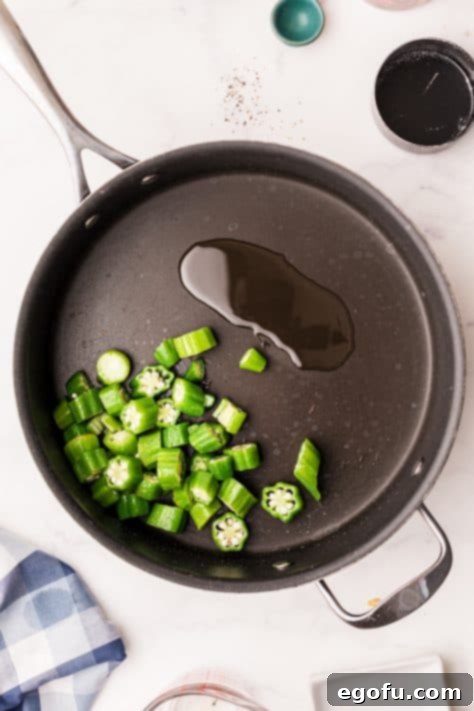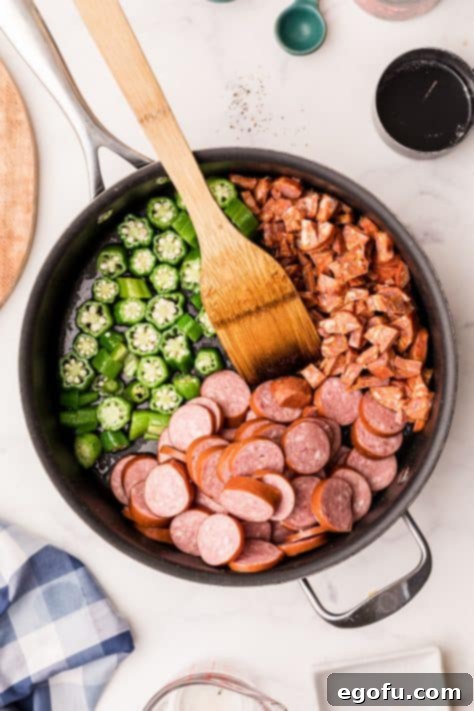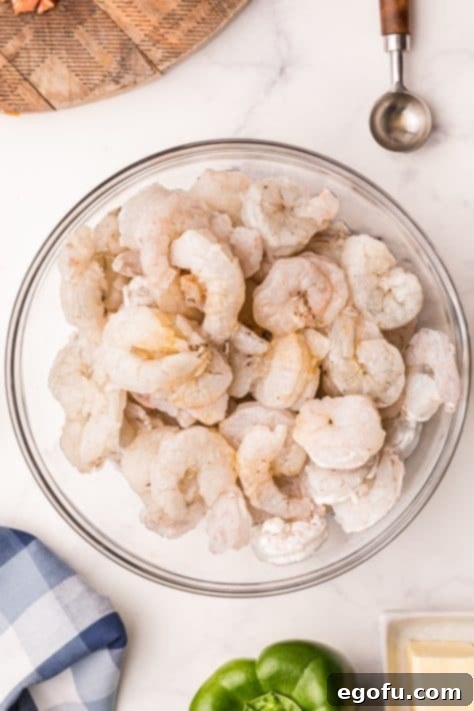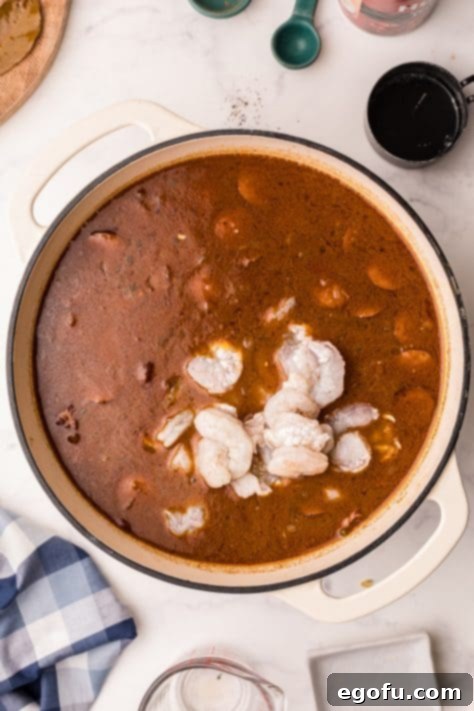This Southern Shrimp Gumbo recipe brings together a rich tapestry of Cajun spices, fresh vegetables, robust sausage, and succulent shrimp, culminating in a truly authentic Louisiana culinary experience. Perfect for any season, this hearty meal promises to transport your taste buds straight to the heart of the Deep South.
SAVORING THE SOUTH: AN AUTHENTIC SOUTHERN SHRIMP GUMBO RECIPE
For those yet to experience the magic of gumbo, consider this your invitation to embark on a culinary journey unlike any other. Hailing from the vibrant culinary landscape of the Southern United States, particularly Louisiana, gumbo is more than just a dish; it’s a cultural cornerstone. Our Southern Shrimp Gumbo recipe, often found gracing tables and menus throughout the region, is a testament to this rich heritage. Its unique blend of flavors, meticulously built over time, creates a depth that’s truly unparalleled. While endlessly customizable to suit individual preferences, this particular shrimp gumbo is traditionally served over fluffy white rice and demands a patient hand to coax out its profound, savory notes. Get ready to create a masterpiece that embodies the soul of Southern cooking.

FREQUENTLY ASKED QUESTIONS ABOUT GUMBO
What is Gumbo Filé?
Gumbo filé is a distinctive seasoning and thickening agent that plays a unique role in traditional gumbo recipes. Made from the dried and ground leaves of the sassafras tree, it possesses a peculiar flavor profile that is often described as earthy, slightly woody, and with aromatic notes reminiscent of root beer or eucalyptus. Historically, filé powder was a culinary secret of the indigenous Choctaw Indians who first inhabited the Louisiana region. It’s typically added by individuals to their own bowls of gumbo just before eating, rather than being incorporated into the entire pot during cooking. This is because filé, if cooked for too long, can become stringy. A small pinch is usually sufficient, as its flavor can be quite potent and might overwhelm other delicate tastes in the gumbo. Whether you love or hate its unique essence, it’s an undeniable part of gumbo’s authentic heritage.
What are some other variations of Gumbo I can make?
Gumbo is wonderfully versatile, with regional and personal variations being a hallmark of its tradition. Beyond this delectable Shrimp Gumbo, one of the most common and beloved versions is Chicken and Sausage Gumbo, offering a heartier, more meat-centric flavor. In coastal areas where fresh catches are abundant, Seafood Gumbo is a popular choice, often featuring crabs, oysters, and various fish alongside shrimp. For those who prefer to avoid seafood altogether, simply omitting the shrimp from this recipe still results in a delicious sausage and vegetable gumbo. Vegetarian gumbos are also gaining popularity, substituting meat stocks with vegetable broth and loading up on a variety of fresh vegetables, beans, and plant-based sausages. Each variation offers a unique experience while retaining the core essence of gumbo’s rich and complex flavors.
What is Andouille sausage?
Andouille sausage is a cornerstone ingredient in Cajun and Creole cuisine, renowned for its robust flavor and smoky character. This heavily smoked pork sausage is distinct from other varieties due to its coarser texture; rather than being finely ground, it often contains noticeable chunks of pork, creating a satisfying chew. It is traditionally seasoned with a bold blend of peppers, onions, garlic, and other spices, giving it a characteristic spicy kick. While traditionally quite fiery, modern variations of Andouille sausage are now available in different levels of spiciness, from super hot to mild, allowing cooks to adjust the heat level of their gumbo to their preference. Its rich, smoky, and spicy notes are essential for building the foundational flavor profile of an authentic gumbo.
What is a roux?
In French culinary terms, a roux is a fundamental thickening agent made by cooking equal parts (by weight) of flour and fat (typically butter, oil, or even rendered animal fat) together over heat. The mixture is whisked continuously until smooth, forming a paste. For gumbo, the roux is more than just a thickener; it’s a flavor enhancer and color foundation. The longer the roux cooks, the darker it becomes, transitioning from a pale blonde to a peanut butter hue, then copper, and finally a deep, rich chocolate brown. Each stage imparts a different flavor profile to the final dish: lighter roux provides more thickening power and a nuttier taste, while darker roux offers less thickening but a much deeper, more complex, and savory flavor, essential for the authentic taste of gumbo. Patience is key when making a roux, as burning it means starting over.
Is there any way to make a quick version of gumbo?
In short, no. And if you ever ask a true Cajun this question, be prepared for a firm and emphatic “absolutely not!” Gumbo is a dish that inherently demands patience and time. Its unparalleled depth of flavor is not something that can be rushed or achieved through shortcuts. Each stage of the cooking process, from slowly browning the roux to simmering the vegetables and meats, contributes incrementally to building a rich, unique, and layered taste that defines authentic gumbo. Attempting to make it in a slow cooker or Instant Pot, while convenient for many dishes, simply cannot replicate the delicate balance and profound flavors developed through traditional stovetop methods. I’ve tried those methods myself, saving you the disappointment – stick to the stove and let time work its magic.
How do I store leftovers?
Storing leftover gumbo is straightforward, allowing you to enjoy this delicious meal for days to come. Once the gumbo has cooled completely to room temperature, transfer it to an airtight container. It can be safely stored in the refrigerator for up to 3 days. To reheat, gently warm on the stovetop over low heat, stirring occasionally, until heated through. For longer storage, gumbo freezes exceptionally well. Pour the cooled gumbo into a freezer-safe container or heavy-duty freezer bags, leaving a little headspace. It can be frozen for up to 3 months. When ready to enjoy, thaw overnight in the refrigerator before reheating on the stovetop.
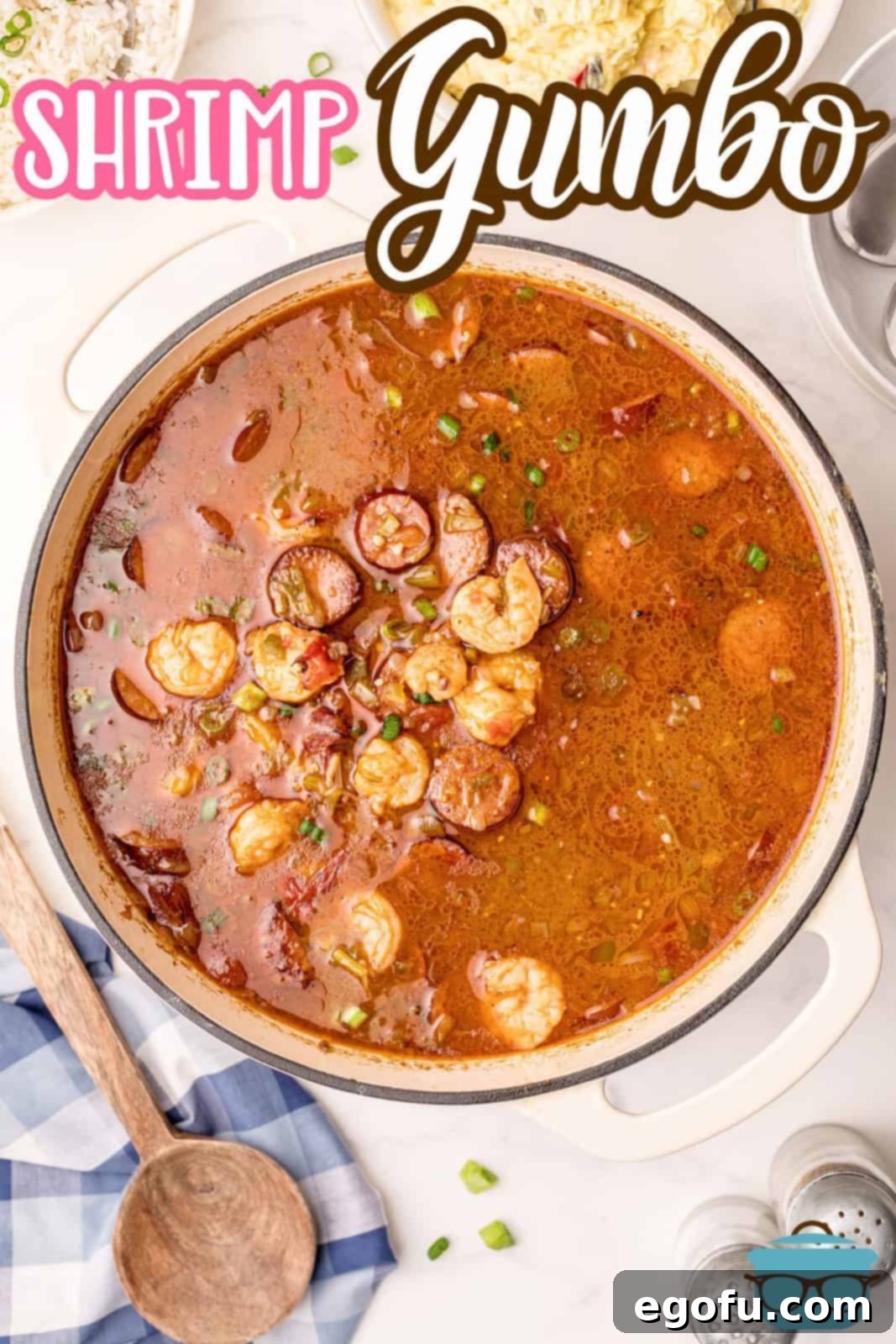
KEY INGREDIENTS FOR SOUTHERN SHRIMP GUMBO
Crafting the perfect Southern Shrimp Gumbo relies on a thoughtful selection of fresh, high-quality ingredients that build layers of flavor and texture. Here’s a detailed look at what you’ll need to create this authentic Louisiana classic:
- Unsalted Butter: We use real butter, not margarine, combined with oil to create the essential roux. The richness of butter contributes to a beautifully flavorful base.
- All-Purpose Flour: The other half of our roux, this flour is crucial for thickening the gumbo and developing that deep, nutty flavor when browned properly.
- Canola Oil: Used in conjunction with butter for the roux, and also for sautéing the okra and sausages. Canola oil has a neutral flavor and high smoke point, ideal for these steps.
- Sweet Onion: A large, diced sweet onion forms a foundational part of the “holy trinity” of Cajun cooking. Vidalia onions are preferred for their mild sweetness, but any sweet onion will do.
- Green Bell Pepper: The second component of the “holy trinity,” diced green bell pepper adds a fresh, slightly bitter note that balances the richness of the gumbo.
- Celery: Completing the “holy trinity,” chopped celery provides an aromatic, earthy crunch and depth of flavor essential to Cajun and Creole dishes.
- Garlic: Minced garlic adds a pungent, aromatic warmth that elevates all the other flavors in the gumbo.
- Bay Leaves: These aromatic leaves infuse the gumbo with a subtle, earthy, and slightly floral aroma during simmering. Remember to remove them before serving.
- Fire Roasted Tomatoes: A 14.5-ounce can of fire-roasted tomatoes adds a smoky, slightly acidic depth that enhances the overall complexity. If unavailable, petite diced tomatoes can be used, though you might miss a hint of smokiness.
- Seafood Stock: The liquid base for our gumbo. Seafood stock brings a delicate brininess that complements the shrimp and sausage beautifully. Vegetable stock can be used as an alternative, especially if you’re mindful of sodium levels, in which case a low or no-sodium version is recommended.
- Black Pepper and Salt: Basic seasonings to enhance and balance the overall flavor profile.
- Creole or Cajun Seasoning: A vital blend of spices that provides the characteristic bold and savory flavor. Brands like Tony Chachere’s or Slap Ya Mama are highly recommended for their authentic taste, though any preferred low-salt blend will work.
- Andouille Sausage: A distinctly smoky and spicy pork sausage that is non-negotiable for an authentic Cajun gumbo. We use one link, sliced, for its intense flavor and hearty texture.
- Smoked Sausage: Another link of your favorite smoked sausage, sliced, adds another layer of smoky flavor and substance. Ensure it’s pre-cooked, not raw. You can use a combination of andouille and smoked sausage, or just one if preferred.
- Fresh Okra: Sliced fresh okra provides a unique texture and helps thicken the gumbo, releasing its natural mucilage. For many, gumbo isn’t complete without it, but it can be omitted if it’s not to your taste.
- Liquid Shrimp and Crab Boil: A teaspoon of liquid shrimp and crab boil, such as Zatarain’s brand, is used to marinate the shrimp, infusing them with a potent, spicy, and aromatic kick.
- Shrimp: Two pounds of fresh shrimp, peeled, deveined, and tails removed, are the star of this gumbo. Pre-deveined shrimp can save valuable prep time.
- Green Onions: Sliced green onions are added at the very end as a fresh, bright garnish, providing a mild oniony zest that cuts through the richness.
- Gumbo Filé: An optional but traditional ingredient (see FAQ above). This ground sassafras leaf powder adds a unique earthy flavor and subtle thickening when stirred into individual bowls. Zatarain’s is a common brand.
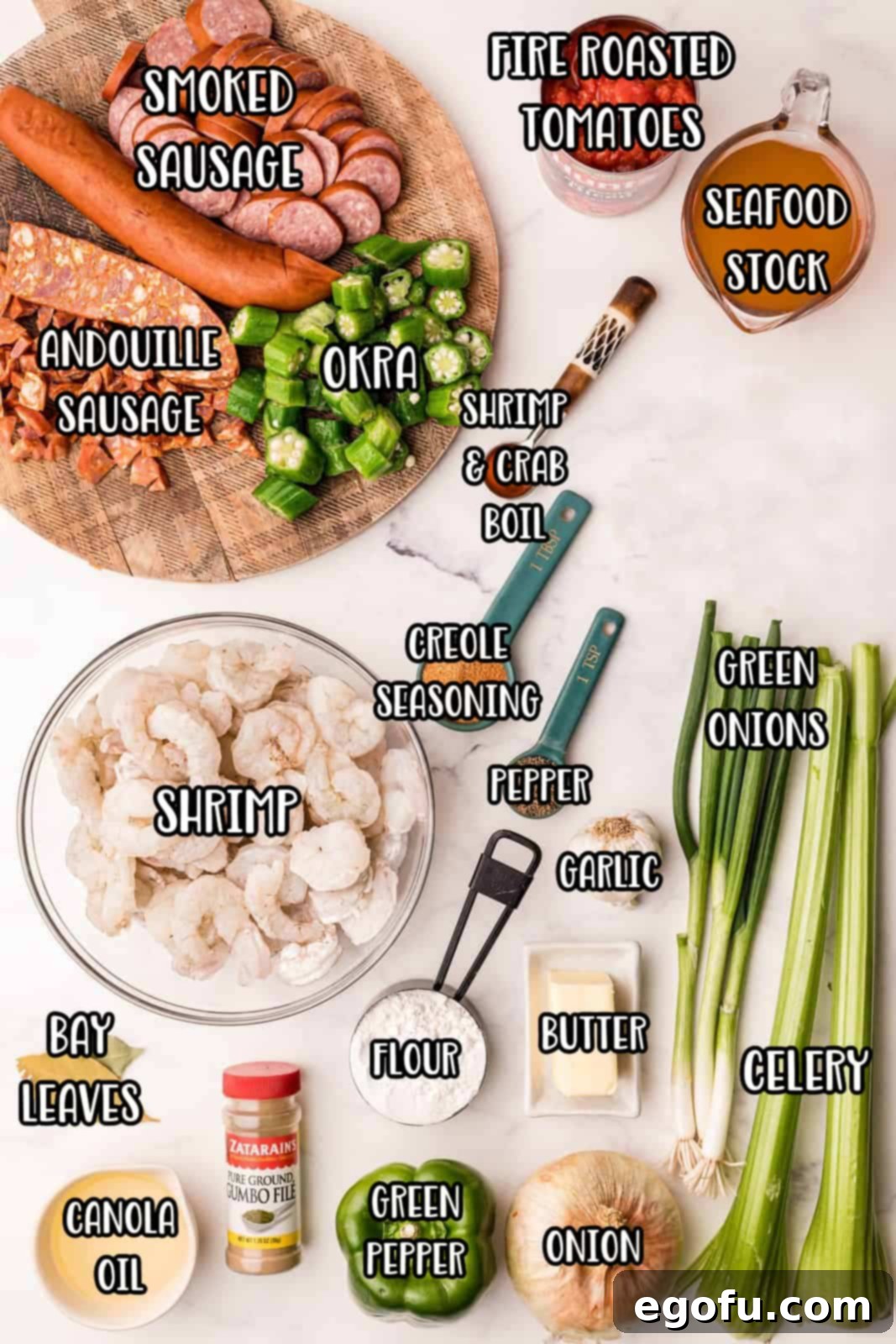
STEP-BY-STEP: HOW TO MAKE SOUTHERN SHRIMP GUMBO
Crafting a truly authentic Southern Shrimp Gumbo is a labor of love, but the rich, complex flavors are well worth the effort. Follow these steps carefully to create a memorable meal:
Step 1: Preparing the Roux – The Soul of Your Gumbo
Begin by melting ¼ cup of unsalted butter and ¼ cup of canola oil in a large, heavy-bottomed pot or Dutch oven over low to medium heat. Once melted, gradually whisk in ½ cup of all-purpose flour. This mixture is your roux, and it requires constant attention. Continue to cook and stir continuously, never letting it burn. The goal is to achieve a beautiful, rich milk chocolate color. This process takes time, sometimes up to 20-30 minutes, so be patient and resist the urge to increase the heat too much. A perfectly browned roux develops the deep, nutty flavor that is the backbone of your gumbo.

Step 2: Building the “Holy Trinity”
Once your roux has reached the desired color, add 1 large diced sweet onion, 1 diced green bell pepper, and 2 chopped celery ribs to the pot. This aromatic trio is known as the “holy trinity” in Cajun and Creole cooking, akin to the French mirepoix, forming the essential flavor base. Sauté these vegetables in the roux, stirring occasionally, for about 10 minutes until they soften and become translucent. Next, stir in 3 cloves of minced garlic and continue cooking for another two minutes, allowing its fragrant essence to infuse the mixture.
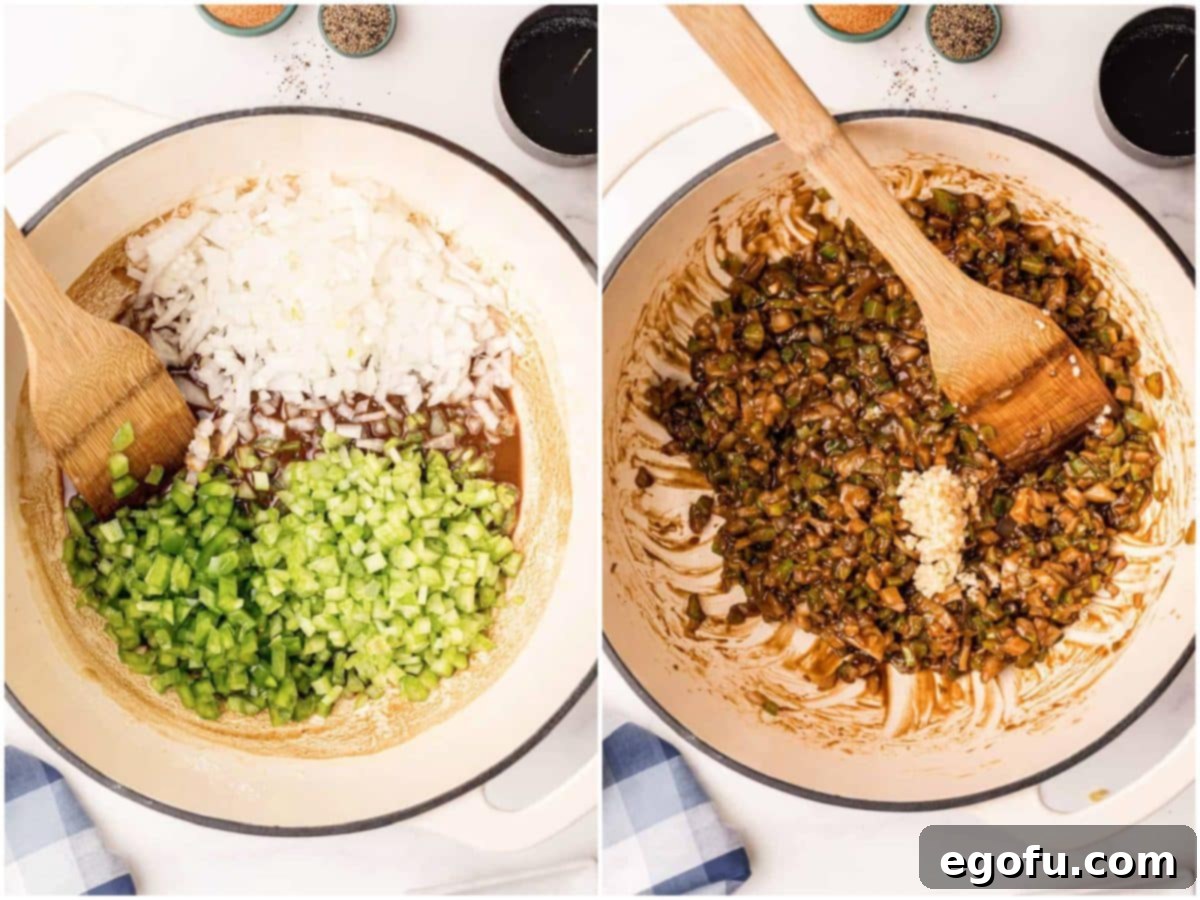
Step 3: Simmering the Base Flavors
Now, add the 14.5-ounce can of fire-roasted tomatoes (undrained), half of the 6 cups of seafood stock (3 cups), 2 bay leaves, 1 teaspoon of black pepper, ½ teaspoon of salt, and 1 tablespoon of low-salt Creole seasoning to the pot. Stir all the ingredients thoroughly to combine. Bring the mixture to a gentle simmer, then reduce the heat to low, cover the pot, and let it continue to simmer while you prepare the remaining ingredients. This step allows the flavors to meld and deepen.
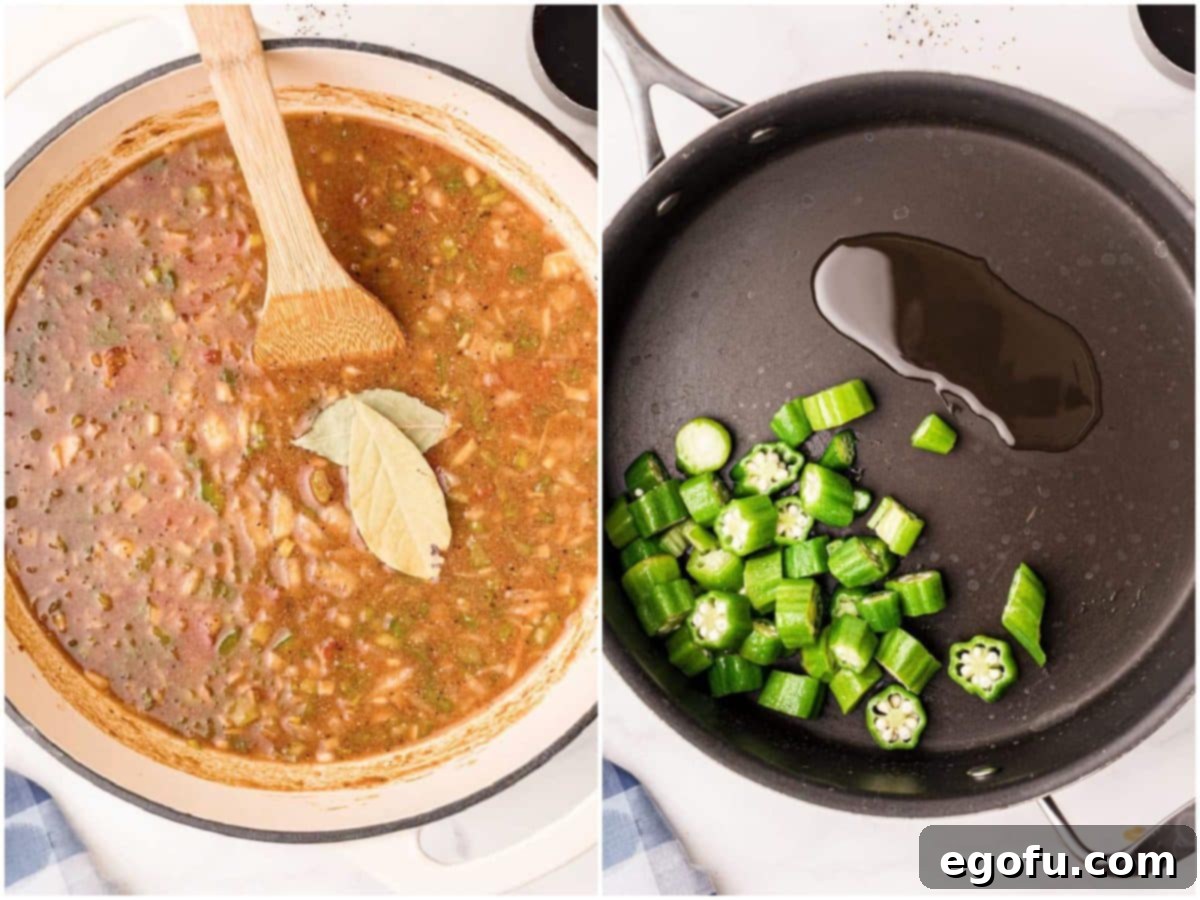
Step 4: Sautéing Okra and Sausage
In a separate large 12-inch skillet, add the remaining 2 tablespoons of canola oil. Add 1 cup of sliced fresh okra to the cool oil (this helps prevent sliminess). Turn the heat to medium. Once the oil is hot, add 1 link of sliced Andouille sausage and 1 link of sliced smoked sausage to the skillet. Sauté the okra and sausages, stirring frequently, for about 15 minutes. Cook until the sausage develops a nice caramelization and begins to stick to the bottom of the pan, and the okra is tender and softened. The stuck bits, known as “fond,” are packed with flavor.
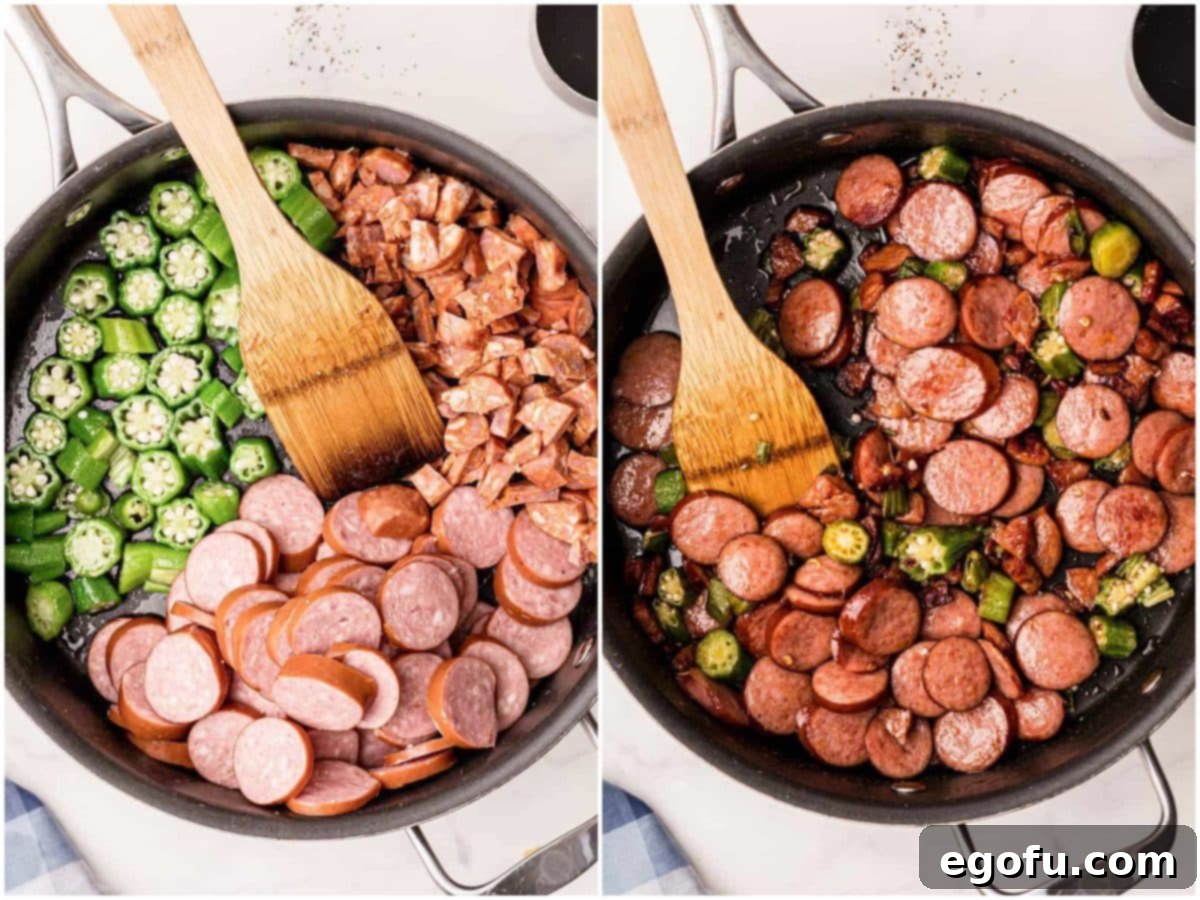
Step 5: Deglazing and Final Simmer
To capture all that delicious flavor, pour a small amount of the remaining 3 cups of seafood stock into the hot skillet. Use a wooden spoon or spatula to scrape up all the caramelized bits from the bottom of the pan. This deglazing step adds incredible depth to your gumbo. Transfer the entire contents of the skillet (okra, sausages, and deglazed stock) into the large pot with the simmering gumbo base. Bring everything to a boil, then reduce the heat, cover, and let it simmer for another 45-60 minutes. This extended simmer is crucial for allowing all the flavors to fully meld and intensify.
Step 6: Preparing the Shrimp
While the gumbo simmers, prepare your shrimp. In a separate bowl, combine 2 pounds of peeled, deveined, and tails-removed shrimp with 1 teaspoon of liquid shrimp and crab boil. Toss to ensure all the shrimp are evenly coated with the seasoning. Cover the bowl and refrigerate the shrimp until you are ready for the final cooking step.
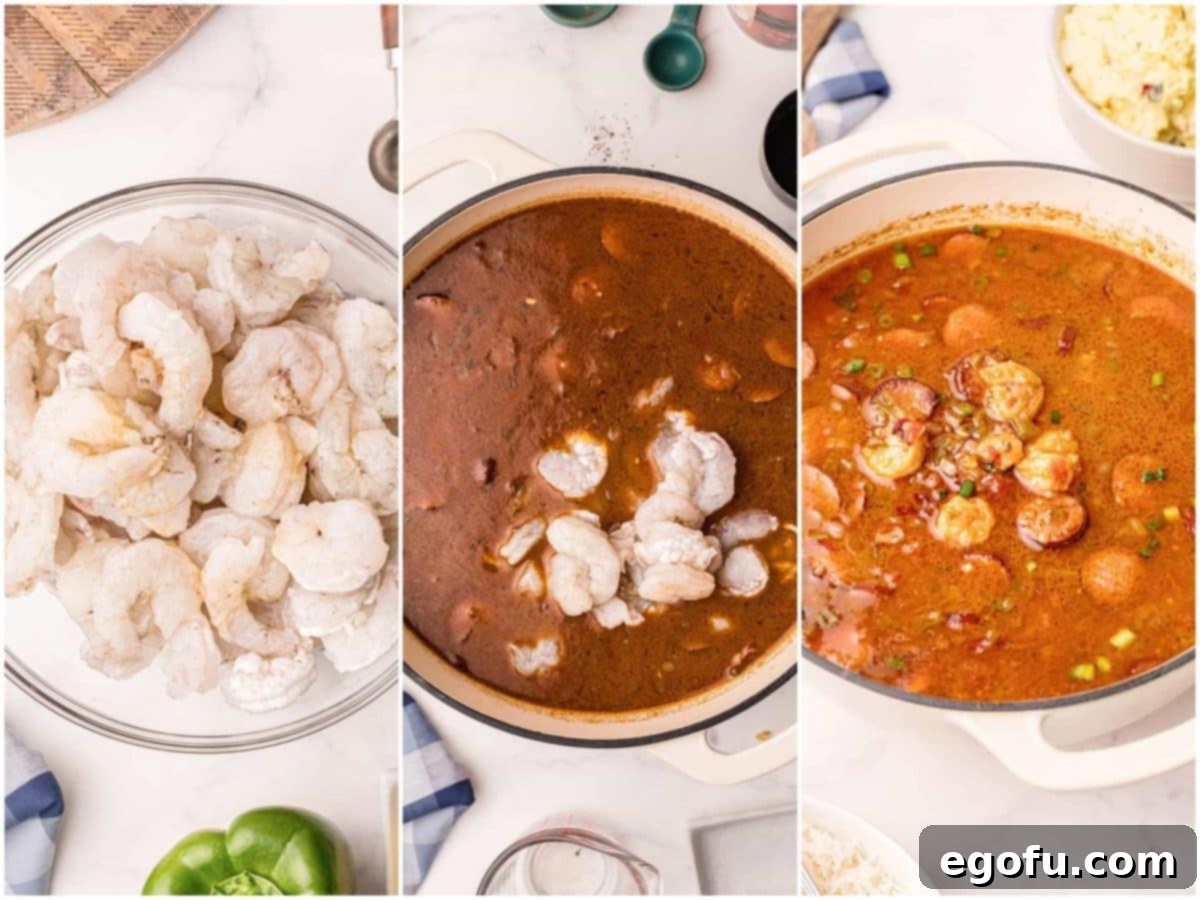
Step 7: Final Assembly and Serving
Approximately 10 minutes before you plan to serve, add the seasoned shrimp to the simmering gumbo. Stir well to distribute the shrimp evenly throughout the pot. Cover the pot once more and cook on low heat for exactly 10 minutes, or until the shrimp are pink and opaque. Shrimp cook very quickly, so be careful not to overcook them, as they can become tough. Once cooked, remove and discard the bay leaves. Stir in 3 sliced green onions for a fresh burst of flavor and color.
Serve your magnificent Southern Shrimp Gumbo piping hot over a generous bed of cooked white rice. For an extra touch of authenticity, offer gumbo filé at the table for guests who enjoy its unique flavor and thickening properties. A side of homemade hush puppies makes for a perfect accompaniment. Enjoy your rich, flavorful taste of Louisiana!
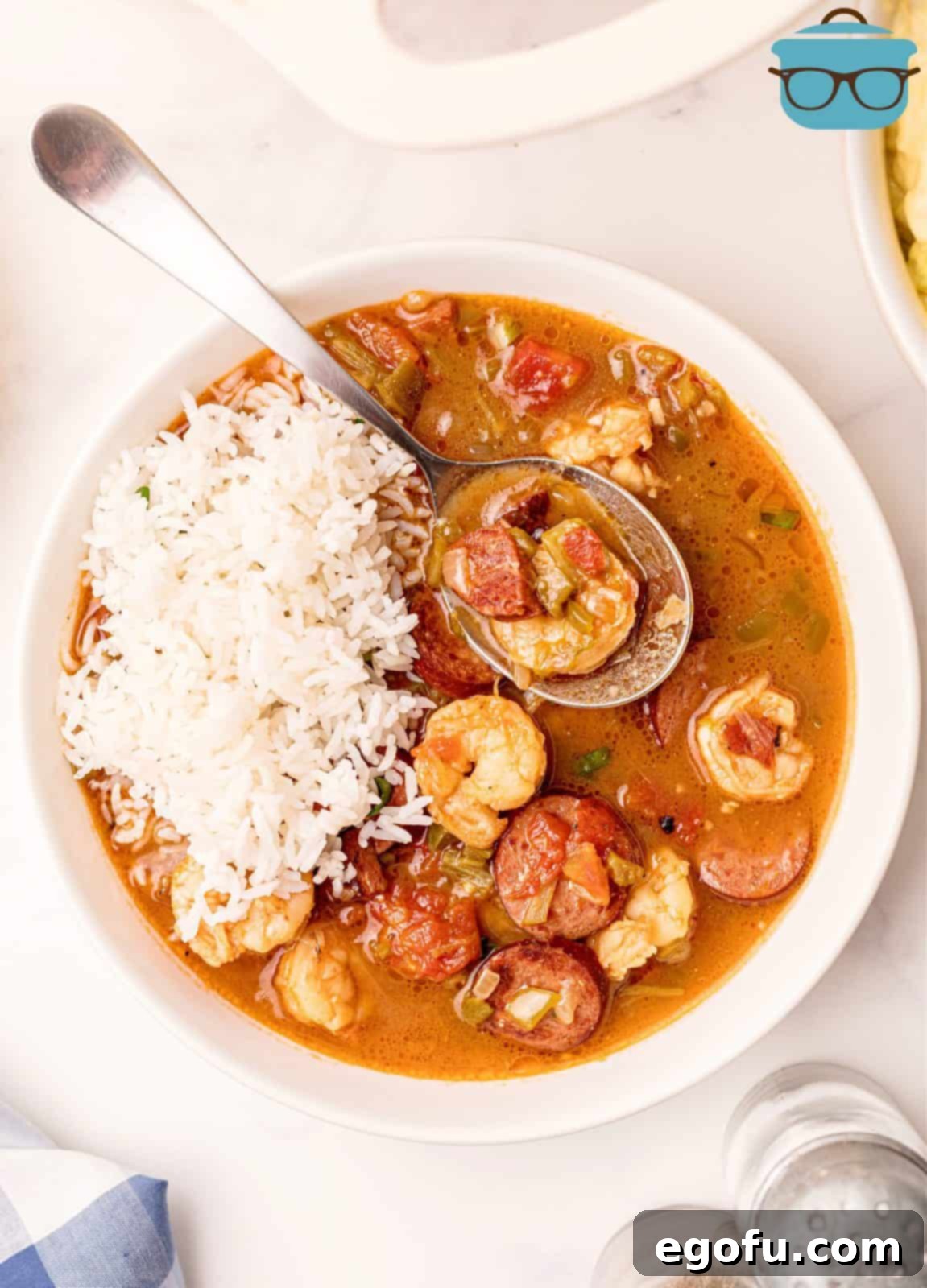
EXPLORE MORE SOUTHERN AND CAJUN RECIPES
If you’ve enjoyed the authentic flavors of this Southern Shrimp Gumbo, you’ll love exploring more culinary delights from the Deep South. Here are some other classic recipes to satisfy your cravings:
- Southern Fried Shrimp
- Red Beans and Rice
- Southern Fried Okra
- Louisiana Jambalaya
- Dirty Rice
- Cajun Rice
- Shrimp Po Boys
- Buttery Creole Shrimp
- Chicken Étouffée
- Instant Pot Dirty Rice
- Crock Pot Shrimp Boil
- Clam Chowder
Originally published: July 2021
Updated and republished: March 2025

Southern Shrimp Gumbo
This Southern Shrimp Gumbo is the perfect mix of Cajun spices, fresh vegetables, sausage and shrimp! It is a true Louisiana meal that can be served any time of year.
Prep Time: 20 minutes
Cook Time: 1 hour
Total Time: 1 hour 20 minutes
Servings: 8
Author: Brandie Skibinski
Ingredients
- ¼ cup unsalted butter
- ¼ cup canola oil + 2 Tablespoons (divided use)
- ½ cup all-purpose flour
- 1 large sweet onion, diced
- 1 green bell pepper, diced
- 2 celery ribs, chopped
- 3 cloves garlic, minced
- 2 bay leaves
- 14.5 ounce can fire roasted tomatoes
- 6 cups seafood stock (divided use)
- 1 teaspoon black pepper
- ½ teaspoon salt
- 1 Tablespoon low salt creole seasoning
- 1 cup fresh okra, sliced
- 1 link andouille sausage, sliced
- 1 link smoked sausage, sliced
- 1 teaspoon liquid shrimp and crab boil
- 2 pounds shrimp, peeled, deveined and tails removed
- 3 green onions, sliced
- gumbo filé (optional)
Instructions
- Melt ¼ cup unsalted butter and ¼ cup canola oil in a large pot, then add ½ cup all-purpose flour. Whisk continuously over low to medium heat until this mixture (the roux) has turned to a milk chocolate color. This will take time. Don’t rush it and do not turn the heat to high.

- Add 1 large sweet onion, diced, 1 green bell pepper, diced, and 2 celery ribs, chopped, and continue to cook, stirring for about 10 minutes. Add 3 cloves garlic, minced, and stir for two more minutes.

- Add 14.5 ounce can fire roasted tomatoes, 3 cups seafood stock, 2 bay leaves, 1 teaspoon black pepper, ½ teaspoon salt, and 1 Tablespoon low salt creole seasoning. Stir well and cover. Allow to gently simmer.

- In a large skillet (12”) add 2 Tablespoons canola oil and 1 cup fresh okra, sliced (add okra while oil is still cool).

- Turn heat to medium, then add 1 link andouille sausage, sliced, and 1 link smoked sausage, sliced. Sauté in the skillet, stirring often for about 15 minutes. Once the sausage looks like it’s caramelized somewhat and is sticking to the pan – and the okra is nice and soft. Use the remaining 3 cups seafood stock to pour a little into the skillet and scrape up the stuck bits (this adds great flavor to the gumbo).

- Add these contents to the pot with everything else and bring to a boil. Cover and simmer for about 45-60 minutes.
- Meanwhile, in a separate bowl, add 1 teaspoon liquid shrimp and crab boil to 2 pounds shrimp, peeled, deveined and tails removed, and stir so that all the shrimp has been coated. Cover the bowl and store in the refrigerator until you’re ready to use it.

- 10 minutes before you’re ready to eat, add the shrimp to the gumbo and stir well. Cover again and cook on low for 10 minutes.

- Remove bay leaves. Add 3 green onions, sliced.
- Serve over cooked rice. Offer gumbo filé for those who enjoy it!

Notes
- If you are not a seafood fan, you can leave the shrimp out and enjoy a delicious chicken and sausage gumbo.
- This recipe makes a generous batch, perfect for feeding a family or doubling for larger crowds.
- Ensure the fresh shrimp are added towards the end of the cooking process, as they cook very quickly to prevent overcooking and maintain their tender texture.
- This recipe can be frozen for up to 3 months; refer to the storage tips in the FAQ section above.
Course: Main Course
Cuisine: American
Nutrition
Calories: 438kcal | Carbohydrates: 16g | Protein: 32g | Fat: 27g | Sodium: 1896mg | Fiber: 2g | Sugar: 4g
Nutritional Disclaimer
“The Country Cook” is not a dietician or nutritionist, and any nutritional information shared is an estimate. If calorie count and other nutritional values are important to you, we recommend running the ingredients through whichever online nutritional calculator you prefer. Calories and other nutritional values can vary quite a bit depending on which brands were used.
Did you make this recipe?
Share it on Instagram @thecountrycook and mention us #thecountrycook!

